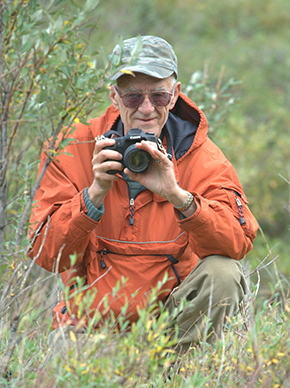Biography —Paul A. Johnsgard
Paul A. Johnsgard grew up exploring the woods and prairies of North Dakota near Christine and Wahpeton. After graduating in 1951 from the North Dakota State School of Science in Wahpeton, he transferred to the North Dakota Agricultural College (now North Dakota State University) in Fargo to complete majors in zoology and botany (BS 1953). As an undergraduate student he wrote and illustrated a 16-page booklet on the waterfowl of North Dakota. A MS (1955) from Washington State College (now Washington State University) in Pullman resulted from his research on the ecology of wetlands in central Washington's Potholes region.
Paul completed a PhD (1959) at Cornell University under Charles Sibley, studying the behavior, morphology and evolutionary history and relationships of the North American mallard-like ducks. During his three Cornell years, he also began the egg-white protein electrophoresis technique famously used by Sibley in his later studies on the taxonomy of the world’s birds; the first avian taxonomic studies based on molecular material.

Paul spent two postdoctoral fellowship years in England at the Wildfowl Trust (now Wildfowl and Wetlands Trust) in the company of Sir Peter Scott, Janet Kear, G.V.T. Mathews, and Hugh Boyd, researching comparative waterfowl behavior, which culminated in his first book, the now classic Handbook of Waterfowl Behavior.
At Sibley’s suggestion, Paul applied for and later accepted a teaching position in the Zoology Department at the University of Nebraska-Lincoln (1961). By his second year at UNL, he had advanced from instructor to assistant professor with tenure. The opportunity to study waterfowl behavior, experience the annual spring migration of sandhill cranes, enjoy lekking prairie-chickens and grassland birds, and live amidst the grandeur of the prairies conspired to keep Paul at UNL for his entire teaching career of 40 years. Paul mentored 12 PhD students and 12 MS students, and taught zoology, ecology, ornithology and animal behavior to more than 7,000 thousand students at UNL, and ornithology for 17 years at Cedar Point Biological Station near Ogallala, NE.
In addition to being a skilled pen and ink artist, Paul is photographer and has illustrated his writings with thousands of photos and drawings. Paul A. Johnsgard is Foundation Professor of Biological Sciences Emeritus at the University of Nebraska. He received the Distinguished Teaching Award, Outstanding Research and Creative Activity Award, and an Honorary Doctor of Science degree from the University. He also was awarded a Guggenheim Foundation Fellowship, the National Wildlife Federation’s National Conservation Achievement Award, the National Audubon Society’s Charles H. Callahan Award, and the American Ornithologists’ Union’s Ralph Schreiber Conservation Award, all in recognition of his ornithological writing and conservation work. To date he has written nearly 60 scholarly books, including nine world avian monographs, several non-technical and fictional books, more than100 peer reviewed articles and about 150 nature-related popular articles, making him the world’s most prolific author of ornithological literature.
Paul Johnsgard, 89, emeritus professor of biological sciences, renowned ornithologist, and prolific author, died May 28, 2021.
For additional biographical information:
- My Life in Biology: Paul A. Johnsgard, Nebraska Bird Review 2010, 78:103-120
- https://digitalcommons.unl.edu/biosciornithology/25/
— Compiled by Mary Bomberger Brown